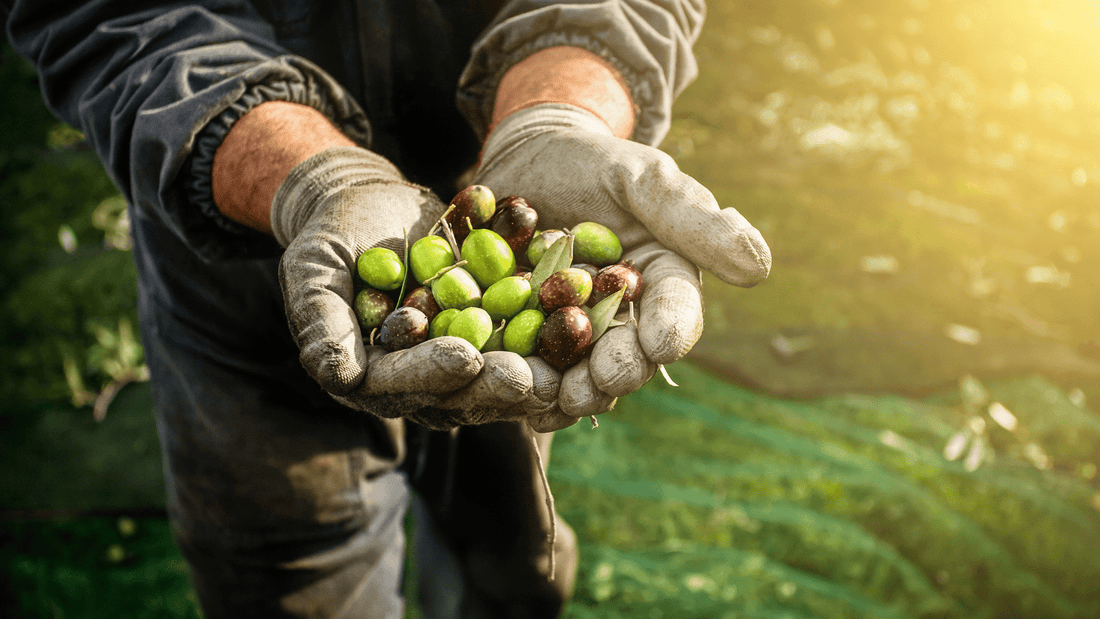Step 1) Traditional olive-pickers hand-pick the healthiest olives and load them onto trucks.
Mueloliva uses traditional olive pickers that hand-pick the healthiest selection of Picudo, Hojiblanca and Picual olives at the beginning of the harvesting season.
This tradition of picking olives by hand has been practiced in Andalusia, Spain for more than 3,000 years. The olive-pickers know exactly what to look for and they only choose the healthiest olives and reject the ones that are damaged.
The olives are separated from their branches and leaves and put into special olive boxes that can handle the weight of the olives.
Olive oil must be extracted from olives within a maximum of 24 hours after picking, otherwise the olives start going bad. This is why Mueloliva loads the separated olives onto trucks and transports them to their production facility as soon as they are picked.
Step 2) The olive fruit is cold-pressed to extract the olive oil.
Jets of water are used to remove any contaminants from the olives. The clean olives are then sent to the pressing/grinding machine. The temperature is controlled at under 27 degrees as advised by International Olive Council.
After grinding, the olives are sent to a machine called the “decanter” for filtration where the olive oil is separated from the olive pulp without the use of any heat or chemicals. This separated olive oil is called first-pressed or cold-pressed olive oil.
Step 3) The first-pressed olive oil is analyzed to determine its acidity.
The first-pressed olive oil is analyzed before anything else is done to it. If the analysis shows that the acidity of the olive oil is below 0.8%, then it is called Extra Virgin Olive Oil.
This Extra Virgin Olive Oil is then packed, sealed and labelled according to the regulations set by the International Olive Council. The packed oil is kept away from light and high temperatures to protect its quality.
Step 4) The first-pressed olive oil with acidity over 0.8% is sent to refinement to bring the acidity down.
According to the regulations set by the International Olive Council and the European Commission, if the acidity of the first-pressed oil is above 0.8%, then it is not Extra Virgin Olive Oil. Instead, it is called Virgin Olive Oil. Virgin Olive Oil must first be refined to bring the acidity down before it can be consumed.
To do this, heat and chemicals are used in a process known as “Neutralization” or “De-acidification”.
After the olive oil is refined and its acidity is brought down, Mueloliva mixes Extra Virgin Classica to it to create a Refined Olive Oil + Extra Virgin Olive Oil blend. This is added to restore some of the nutrients and antioxidants lost in the refining process.
Mueloliva has 2 kinds of Refined Olive Oils: Extra Light and Mild Olive Oil. Both these refined oils are blended with Extra Virgin Classica to restore the nutrients lost in the refining process.
Step 5) Pomace olive oil is extracted from the olive pulp and further refined.
Remember the olive pulp we talked about in step 2? This olive pulp still has olive oil inside it but it cannot be extracted through the first-press method. To extract the remaining oil, solvents are used which absorb the oil out of the olive pulp.
The extracted oil and solvent mix is sent for further refinement and filtration that separates the olive oil from the solvents.
The refined and filtered pomace olive oil is then blended with Classica and it is bottled and sealed. This is how Mueloliva Pomace Olive Oil is produced.
Step 6) All categories of Mueloliva olive oils are now ready for export.
All Mueloliva olive oils, including Extra Virgin, Refined (Extra Light and Mild) and Pomace olive oil have now been bottled, sealed and appropriately labelled. All of the processes listed above are completed within 24 hours of picking the olives.
The different Mueloliva Olive Oil varieties are then exported to over 70 countries around the world, including Pakistan.

